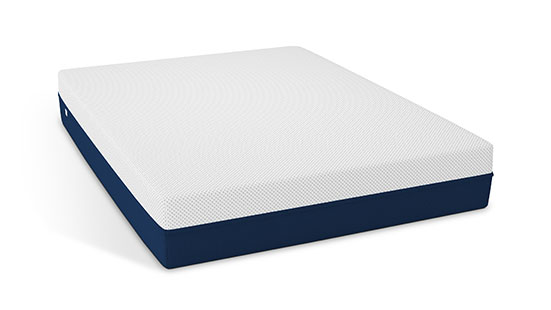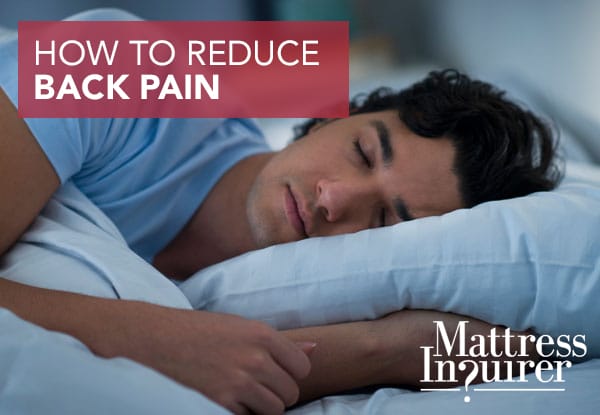Are you one of the 80% of people who experience back pain from time to time? Back pain has reached nearly epidemic proportions, with nearly one-third of the population suffering from pain in their necks and backs almost daily.
Uncovering contributing factors and remediating them may help eliminate or reduce these aches and pains, which can have a significant impact on well-being. One key area to examine is the bed since it’s where we spend around one-third of each day.
The quality and construction of your mattress and individual things like sleep position and health can all have an impact on comfort. Read on to learn a few steps you can take to avoid and reduce back pain during sleep and throughout the day.
Best Mattresses for Back Pain
First, if you notice that your pain is the worst at night or after waking, your bed might be the first place to check. Here are a couple of options that tend to do well with reviewers (more on beds and pain relief below).
| Brand | Owner Satisfaction | Price Range (Queen) | Notes | Warranty |
|---|---|---|---|---|
| Amerisleep | 93% | $1099 - $1999 | 8”-14” profile 2”-3” memory foam Plant-based | 20 year |
| Sealy Optimum | 77% | $1074 - $2274 | 10”-13” profile 3”-6” gel memory foam Gel and traditional | 10 year |
| Simmons Comforpedic | 77% | $1100 - $2300 (est) | 9.5”-13” profile 3-5” memory foam Gel and traditional Medium density | 10 year |
| Tempurpedic | 81% | $1699 - $7499 | 8”-15” profile 3”-7” memory foam Traditional Medium to high density | 10 year |
The Mattress and Pain Connection
The average person changes their sleeping position between 40 and 60 times during a typical night. One study conducted by RTI International graphed movement during the night and compared it to how people rated their rest the following day. This study showed that the less movement that occurred during the night, the more rested they were the following day.
You may be asking yourself how this correlates to back pain. Well, if your mattress is not providing adequate support and comfort, you are likely going to be more restless during the night, switching positions in an attempt to alleviate discomfort.
A different survey conducted by the British Chiropractic Association also found striking connections. Around 30% of respondents reported neck and back pain after sleep, and 83% said they feel stiff and sore in the morning. Study authors suggest that a high percentage of people that had mattresses older than 10 years may be a contributing factor.
Oklahoma State University researchers also found that people slept better and felt less pain on a new mattress compared to their older ones, which averaged 9.5 years old. The exact mattress wasn’t extremely important in their research, simply having a new bed was enough for better comfort (at least initially).
Choosing the best bed to keep your back happy is mainly a function of firmness, preference, and age.
When a Bed is Too Soft
A mattress that is very soft may feel wonderful when you initially lie down, but during the night, your body will relax and you will sink into the bed, and if it lacks support, this can contribute to lower back pain as the spine shifts out of its natural alignment, or result in numbness or tingling in the limbs due to nerve compression.
Do you know what your sleep position means? Sleep Junkie has the answers
When a Bed is Too Firm
A firm mattress is a common recommendation for people looking to avoid soreness and stiffness. However, an overly firm mattress has a similar effect in some ways as one that is too soft, forcing the body to conform to the hard surface, throwing out your spine’s natural alignment. A bed that feels too hard can also cause discomfort around pressure points.
When a Bed is Too Old
Similarly, a mattress that is very old may lack the resiliency to contour adequately and provide support. Over time, springs lose their ability to bounce back. Foams and fiber tend to compress and soften, and worn down cushioning layers can contribute to pain and pressure points.
Research by Sleep Like The Dead found that deep impressions in mattress surfaces were associated with higher pain meaning that when your bed starts to show signs of wear, it may be time to look around.
The average lifespan for a bed is 7 to 8 years, but some may need to be replaced sooner, particularly beds that use lower quality materials or see heavier wear.
Useful Sleep Tips for Back Pain Sufferers
If you suffer from regular back problems, there are a few things you can do to relieve or at least minimize the severity.
1. Try a new pillow. The pillow you use can have an effect on your spinal and neck alignment. If you are back or stomach sleeper, flatter pillows are generally better, whereas side sleepers need loftier pillows. Your head should sit at a natural angle to your neck throughout the night (parallel to the ground if you sleep on your side, or at a neutral standing angle for back sleepers). Opting for a different thickness or material could have big benefits.
2. Try a topper. If your pain is due to a mattress being too stiff or a firm, a feather or memory foam topper could be a good way to reduce pressure points if the underlying bed is still in good shape. They can also help with lumbar support, thus reducing lower back tension.
3. Rotate your bed. Every mattress should be rotated (from head to toe, only flip if you have a two-sided mattress) a couple of times a year to ensure even wear and prevent impressions.
4. Support your mattress. One potential contributor to aches and pains, especially for mattresses that aren’t overly old, is insufficient or incorrect support. Box springs that are worn out can cause premature sagging, as can slats that are spaced too far apart in platform-style beds. Foam and spring mattresses can feel overly stiff on very hard foundations as well.
5. Modify your sleep position. The Mayo Clinic suggests for reducing back strain:
- Back sleepers should place a small pillow beneath their knees.
- Stomach sleepers should place a thin pillow below the hips.
- Side sleepers should place a small pillow between knees.
An adjustable bed can also be helpful since it allows you to elevate legs and upper body at custom levels. Trying different angles and positions (whether with pillows, wedges or an adjustable bed) can help you find your ideal way of sleeping.
6. Stretch before and after bed. Light stretching before bed and in the morning can be very helpful for reducing stiffness and sore back muscles.
7. Replace your mattress. If your bed is more than 8 years old or if you notice significant signs of wear it might be time to go. These include body impressions, sagging, hammocking, and changes in firmness that affect comfort. Very minimal sagging is associated with decreased sleep quality and discomfort.
8. Keep support in mind during the day. As you work during the day, take regular breaks to stretch and walk around. Monitor yourself to make sure you’re sitting with good posture, and try not to stand in non-ergonomic positions too long. A lot of back discomfort is occupation-related, so checking with a doctor or chiropractor on ways to prevent strain and knowing your limits can also help.
Our Top Pick to Help Reduce Back Pain:
Amerisleep’s AS2 Bed

What Amerisleep Does Right
As an affordable memory foam mattress, the Amerisleep AS2 delivers the right balance of pressure relief and substantial support with quality materials designed to provide lasting comfort. The AS2 will always keep your spine in perfect alignment, especially when sleeping on your back or stomach.
Amerisleep also includes a soft, breathable cover that is designed to encourage airflow and help you sleep cool and comfortable. The cover is machine washable so it is easy to keep your mattress clean and in good condition.
What Else to Consider
If you’ve determined your mattress is the culprit of your back pain, then it’s time to pick a new one. When you do start shopping, here a few important things to consider, beyond personal comfort preferences:
Firmness matters.
The level of firmness preferred by most people, including those looking to relieve aches, is medium-firm, particularly for back pain reduction. Medium-firm is a good bet, though smaller back sleepers may prefer firmer beds, and side sleepers may need a little more padding. Get a good idea of you and your partner’s preferences to determine what would work best.
Try different types.
No one mattress type or brand is going to be right for every person. Familiarize yourself with the pros and cons of different beds, and read reviews to see what others with similar preferences say. You may find that specialty mattress is better suited to your needs, or you may find your body likes springs best. Comfort is a very unique thing, and it’s worth checking a wide selection of mattresses.
Many people with pain like memory foam for its ability to reduce pressure points and contour to the sleeper (usually around 80% in general, compared to 65% for springs). Memory foam also earns slightly better scores on durability compared to average spring beds. Memory foam isn’t as expensive as many people think either — some of the top-rated memory foam brands like Amerisleep and Tempurpedic are priced similar or even below similar-quality spring beds.
Unfamiliar with different types of beds? Learn the benefits of memory foam, innerspring and more
Get a strong warranty.
If your mattress wears out early, it can lead to pain. Check the warranty before purchasing, and choose a company that provides transparency, including the length of the full replacement and proration terms. If the manufacturer requires impressions deeper than one-inch to make a claim, for example, you could be more likely to have sagging and thus pain.
Get a return policy.
This provides you with the opportunity to determine whether you have chosen the best type and firmness level to help alleviate back pain. Choose a mattress from a company that provides at least 30 days of in-home trial. Some companies provide the opportunity to exchange firmness levels or return the mattress during this time period. It is important to read the policy thoroughly.
Healthy, comfortable sleep is one of the keys to beating the pain epidemic. Pain levels and stress soar when we don’t feel well-rested and are further irritated by a lack of support. Finding the right mattress for back pain and optimizing your sleep style are two ways you can take control and feel better throughout the day.
What helps you sleep better, or what tricks do you use to avoid nighttime back pain? Share below.
